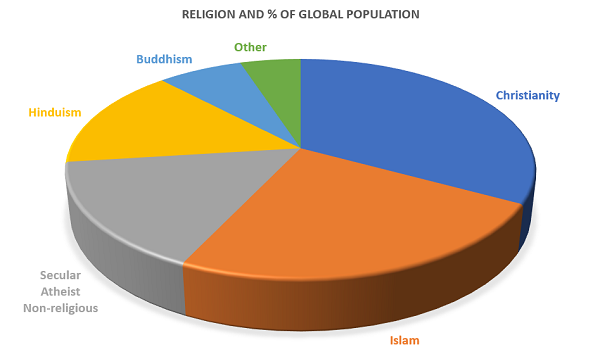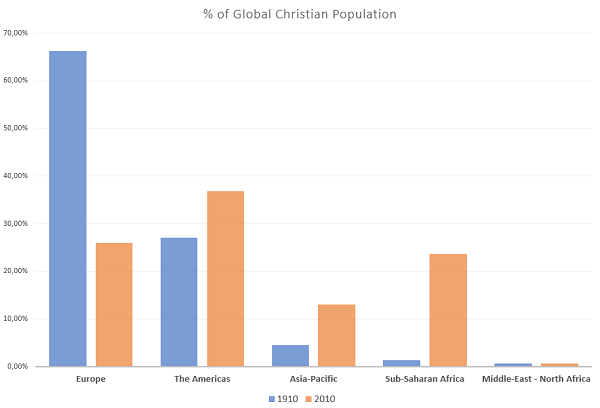As a religion, Christianity has been around for millennia. It has changed and transformed throughout time – both in terms of the principles and beliefs, the range of denominations it is comprised of and the number of religious believers across the globe.
Amongst all worldly religions, Christianity remains the most widely practiced. There are more fascinating statistics than just the number of religious believers, however, and it is these mind-blowing figures that we’ll be examining in the following article.
2.4 Billion People Are Christians
Christianity certainly isn’t the only prevalent religion in the world, but it might come as a shock to learn that, amidst Islam, Hinduism, Buddhism, and all other major religious schools, Christianity is by far the most popular.
Global assessments conducted in 2012 revealed that the precise figures pertaining to the most-followed world religions were:
| Religion | Followers | % of Global Population |
|---|---|---|
| Christianity | 2.4 billion | 33% |
| Islam | 1.8 billion | 24.1% |
| Secular/atheist/non-religious | 1.2 billion | 16% |
| Hinduism | 1.15 billion | 15% |
| Buddhism | 521 million | 7% |

Quite clearly, Christianity exceeds the other four major religious/non-religious bodies by a significant proportion of 0.6 billion – overtaking Islam in number of followers by an astounding 9.1% of the global population.
The figures have varied throughout history, though, and the number and spread of Christians worldwide has changed dramatically in the past century alone.
Changes in Christian Populations Throughout History
According to a survey conducted by the Pew Research Center, there were only an estimated 600 million Christians worldwide in 1910. This figure has increased enormously in more recent years, with an estimated 2.2 billion Christian followers recorded in 2010.
The research center also predicts that Christianity will remain the world’s largest religion for the next four decades if these trends continue, with a projected 2.9 billion people practicing Christianity worldwide by 2050 and exceeding 3 billion thereafter.
Christianity is expected to remain the largest religious group throughout North America, Europe, Latin America, and Sub-Saharan Africa, too, with more than 50% of each respective population practicing Christianity.
The marked spread of Christianity across non-Western countries has significantly altered the distribution of Christians throughout the planet. During the 1900s, Christian faith was most prevalent throughout Europe and the Americas – claiming around 93% of the the entire global Christian population. In 2010, however, only 26% of the global Christian population was located in Europe, with 24.4% Latin America and the Caribbean and 12.3% in North America – a combined total of 62.7%. With the increase in the number of followers of Christianity in the past century has come a significant shift in their geographic distribution.
Protestantism, in particular, has spread swiftly throughout the continents of Africa, Asia, and Oceania since the early 1900s. A lot of this growth occurred after World War II, during which Africa was decolonized and the strong restrictions against the practicing or Protestantism worldwide were abolished.
Modern-day Christians are spread more thinly across a number of different countries, whereas previously they were concentrated into smaller areas. Let’s take a look at how the spread of the Christian population has changed geographically in the past century.
There Are More Christians in America Than Any Other Continent
While Christian populations were primarily located in Europe and the Americas in the 20th-century, today Christian faith has spread itself worldwide. A comparison of the precise numbers and locations from 1910 to 2010, as recorded by the Pew Research Center, can be seen in the tables below.
Global Distribution of Practicing Christians in 1910
| Country | % of Global Christian Population |
|---|---|
| Europe | 66.3% |
| The Americas | 27.1% |
| Asia-Pacific | 4.5% |
| Sub-Saharan Africa | 1.4% |
| Middle-East – North Africa | 0.7% |
Global Distributions of Practicing Christians in 2010
| Country | % of Global Christian Population |
|---|---|
| Europe | 25.9% |
| The Americas | 36.8% |
| Asia-Pacific | 13.1% |
| Sub-Saharan Africa | 23.6% |
| Middle-East – North Africa | 0.6% |

When looking at the data, it’s clear to see that the distribution of Christian followers worldwide has shifted quite significantly in the past the short timeframe of 100 years. Whereas previously Europe far-exceeded all other regions in terms of their Christian population, since 2010, the Americas have taken the lead by far.
In areas like Asia-Pacific and Sub-Saharan Africa, Christian populations have increased more than tenfold, with Sub-Saharan Africa trailing closely behind Europe. Part of the reason for this is the abolition of anti-Protestant laws that governed Africa during the 20th-century, as well the abandoning of a number of other secular laws worldwide.
Each year, Christianity gains around 65 million more followers due to a range of different factors, including birth rate, religious conversion, and migration. Conversely, 27.4 million Christians are lost annually due to factors including death rate, immigration, and apostasy, or loss/renunciation of belief.
Geographically, the net growth in Christian populations has been most prevalent in Africa, Latin America and Asia. By 2050, it is predicted that Christianity will remain the majority religion in the US, growing in number from 243 million to 262 million.
One study conducted in 2018 by the Pew Research Center shows that Christianity is still the largest religion across all of Western Europe, with 71% of the population identifying as Christians. Interestingly, the same study showed that the vast majority of individuals raised as Christians remained Christian so later in life.
Christianity has also spread throughout countries such as South Korea which aren’t shown in the table above. South Korea has seen a dramatic increase in Christians between 1945 and 2010, moving from 2.0% to 29.3%.
Pentecostalism is the Fastest-Growing Religion in the World
Although less prevalent in popular culture and news when compared to major denominations such as Catholicism and Church of England, Pentecostalism has been shown to be the fastest-growing religion worldwide, according to a 2005 paper.
Pentecostalism is a form of Christianity that emphasizes the importance of the Holy Spirit and the direct experience of the presence of God by the believer. It holds that faith should be experiential rather than something discovered only through rituals and scripture. Members of the Pentecostalist church believe their actions to be driven by the power of God.
The underlying belief behind Pentecostalism is that their movement is returning Christianity to its simplest form – that which has the most in common with the early stages of the Christian church. Perhaps it is for this reason that Pentecostalism is growing so rapidly in popularity, as modern denominations like Catholicism have moved far away from their old traditions in an attempt to modernize Christian doctrine.
Protestantism
The Protestant church, which gives utmost authority to the Bible and believes that any other source of scriptural truth detracts from the sanctity of the Bible, has also seen a boom in numbers in recent years.
This is thought to be a result of religious conversion throughout Asia, Latin America, Oceania, and the Muslim world. In Vietnam alone, Protestantism has grown by an astounding 600% in the past 10 years alone.
An estimated 37% of Christian believers belong to the Protestant faith, which has since been redefined to include Anglican (Church of England) followers and members of independent/nondenominational churches.
Catholicism
In 2013, the number of followers of the Catholic Church was 1.253 billion – comprising 17.7% of the global population. This is a dramatic increase from the figured in 1950, wherein only 437 million people followed Catholicism and 654 million in 1970. The most significant areas of growth have been in Asia and Africa.

In 2010, Catholics were reported to comprise around half of all Christians.
Other Denominations
The Orthodox Communion, which includes Greek and Russian Orthodox, made up 12% of all Christians while other groups, including Jehovah’s Witnesses and Mormons, made up only 1%.
10.2 Million Muslims Have Converted to Christianity
A number of different studies and reports estimate that many more people have converted from Islam to Christianity during the 21st century than any other point throughout the history of Islam. Oftentimes, Muslims that convert to Christianity face the risks of social rejection and even imprisonment and murder in more radical states. Regardless, one global census suggests that 10.2 million Muslims have converted to Christianity worldwide – most significantly in countries such as France, Germany, Indonesia, Turkey, and Belgium.
Throughout the 1900s, more than 250,000 Jewish people were seen to convert to Christianity. The Pew Research Center holds that around 16 million American Jews identify themselves as Christian – specifically Protestants. The same study suggests that of the Jews who identify as Christians, most of these were raised as Jewish.
Interestingly, some reports show that the number of young people becoming Christians is also on the rise across several different countries. Conversion is also increasing amongst Korean, Chinese, Japanese and American individuals, moving from faiths like Islam, Hinduism, and Buddhism to Christian denominations in spite of the risk of persecution.
It is clear that, although the movement of the Western world seems to be directed towards more secular ideologies, Christianity is as prevalent now as ever, growing at an increasingly rapid rate in other areas of the world. Things seem to be a little different in Europe, however.
Christian Populations in Europe Are on the Decline
As of 2012, 2.4 billion Christians were reported worldwide, representing one in every three people worldwide. This makes Christianity the world’s largest religion.
Approximately one-quarter of the global Christian population was found to be in Europe, comprising 26% of worldwide believers, with a further quarter in Latin Amerca and the Caribbean and another in Sub-Sahara Africa.
Between now and 2050, the regional and geographical distribution of Christians is predicted to undergo further changes. It’s projected that Europe will hold only 16% of the global Christian population by then.
Facts and Statistics About the Bible

As well as Christianity itself, there are a number of fascinating truths and statistics surrounding the literary crux of the Christian faith, the Bible. Some of these are listed in bullet points below.
- The Bible can be read aloud in 70 hours.
- There are 8,674 various Hebrew words scattered throughout the King James Version of the Bible, as well as 5,624 Greek words and 12,143 English words.
- The approximate number of Bibles sold, given away or distributed in the United States every day is 168,000, according to statistics from Wycliffe International, Gideons International, and the International Bible Society.
- The bestselling and fastest-growing translation of the Bible in the United States is the King James Version.
- 20 million Bibles are sold worldwide in the United States alone.
- 92% of Americans own at least one Bible, whether as a gift or a purchase, but only 12% read it daily.
- There are 40 authors of the Bible.
- The Bible is excluded from bestselling book lists because it would always rank the highest, with the average American owning 9 Bibles.
Bible Sales Earn More Than $400 Million Every Year
It is clear that the Bible is immensely popular worldwide, matching the statistics which indicate that Christianity is the most-followed global religion. Across the planet, Bible sales bring in an estimated $425 in revenue annually.
Over 100 million copies of the Bible are printed every single year, with religious believers and consumers in the United States purchase an average of 25% of those books. Interestingly, the Bible also holds a record for as being one of the least-sold books, with a translation of the New Testament into Coptic selling only 2 copies in any year since 1971.
Although some of the more esoteric translations of Biblical texts generate far fewer sales than those such as the King James Version, there are more than 80,000 different translations, each selling at least one copy per year and many selling exponentially more.
The Growing Popularity of Digital Bible Resources
As well as physical copies, digital Bible resources have also soared in popularity since their introduction in the past 50 years. YouVersion, for example, a top-downloaded app for mobile services, has received over 100 million downloads and counting. It’s been amongst the top-100 free iTunes apps for 3 consecutive years.
Furthermore, over 60,000 people have been recorded to be using a Bible app at any given moment, with three people every second sharing some form of Biblical quote or verse to their social media outlets. Isaiah 41:10 is one of the most popular Biblical verses online, according to YouVersion.

77% of people claim that mobile services have enabled them to read the Bible more frequently, and perhaps this is part of the reason for the rapid growth in Christian followers in recent years. Two-thirds of people also state that they prefer bible apps because these give them access to multiple versions of the Bible without added costs. It’s clear that Bible-reading apps are rapidly transforming the way people are accessing and reading Scripture.
Although Bible sales have been steadily increasing for many years now, not all purchasers of Scripture are as knowledgeable in the text as their actions might have us believe. Brandon Gaille cites a Gallup poll stating that less than 50% can name the first book of the Bible, and only 1 in 3 people is aware that Jesus delivered the Sermon on the Mount. Amidst all Americans that possess a Bible, only 12% are said to read it every day.
Regardless, the religion continues to grow at record speeds. Whether believers are as committed to their faith as the numbers might suggest, there’s no doubt that the number of people that identify themselves as Christian is on the rise.
Conclusion
When looking at the range of fascinating statistics surrounding both historic and contemporary Christianity, it becomes clear that even where Western culture may appear to be becoming more and more secular, Christian faith is still very much alive and kicking.
With more than 2 billion believers worldwide, Christians make up almost a quarter of the entire global population – far more than any other religion.
As digital Bible-reading sources begin to become more and more accessible and religious education more prevalent, it is predicted that Christianity will continue to grow at an ever-increasing rate. It’s sure to hold its title as the most widely-practiced religion globally for many years to come.





